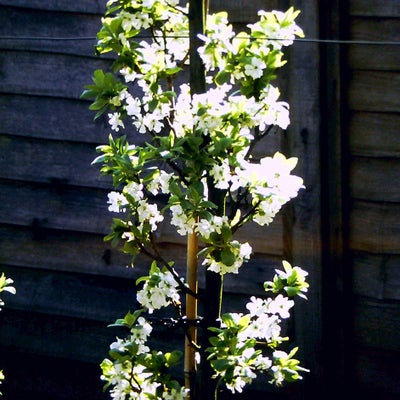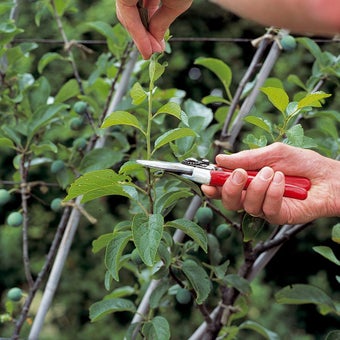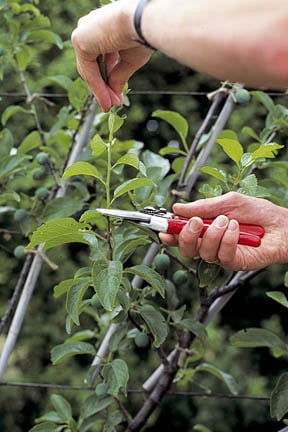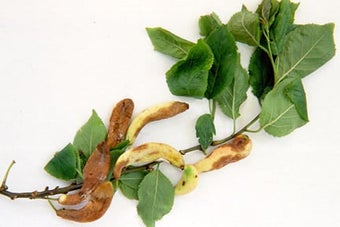
Quick facts
Suitable for - Plums
Timing - Plant in winter, prune in summer
Difficulty - Difficult
Suitable for...
Plum cordons are excellent for the small garden. They are simply single-stemmed fruit trees with short sideshoots (fruiting spurs).
Any plum cultivars can be grown as cordons by using the dwarfing rootstock ‘Pixy’, but the best results are from those cultivars which are naturally compact such as ‘Early Laxton’, ‘Czar’ and ‘Blue Tit’.
How to plant and train plum cordons
Cordons can be planted and trained obliquely or vertically. The oblique is preferable as it encourages the production of sideshoots. If you are growing more vigorous cultivars, double and triple cordons are a better choice of form.
- Plant one- or two-year-old bare-rooted cordons in winter. Container-grown plants can be planted throughout the year
- Choose a site that is open and as sunny as possible, with shelter from severe frosts that can damage blossom
- Vertical and double cordons (‘U’-shaped) can also be grown in containers (at least 45cm (18in) wide) in John Innes No 3
- The supporting system of posts and wires is the same as for apple and pear cordons
- If you are planting more than one row, space the rows not less than 1.8m (6ft) apart
- Plant the trees in well-drained soil at an angle of 45 degrees with the scion/rootstock union uppermost and 75-90cm (30in-3ft) apart. The root flare should be just under the surface of the soil
Initial training
The angle of the main stem slows the movement of and encourages more even growth.
- Trim any side shoots back to three or four in March to April.
- Prune the leading shoot by one third to a suitable and thereafter prune in summer.
- Tie the cordon to a bamboo fixed to the wires. Where subsequent growth is poor, incline the tree more towards the vertical until sufficient growth has taken place.
- When the cordons reach the top wire, they may be lowered to obtain more length of stem, but no more than 5 degrees at a time and to no lower than 35 degrees so that there is less risk of the stem breaking.
- Once the cordon has reached the desired length, prune the leader back to about 1.5cm (½in) each May.

Pruning
The pruning of cordons is carried out to concentrate growth into fruit and maintain a manageable tree.
Timing
Prune established plum cordons in summer (July to August): they should never be pruned in the season because of the risk of silver leaf infection.
How to prune established plums
- ‘Stop’ the current growth (i.e. cut off the shoot tip) on each to leave six leaves
- Growth produced after the ‘stopping’ is pinched back to one leaf beyond the previous pruning mark
- After fruiting, prune back these shoots to three leaves to create fruiting spurs
- Some growers suggest that it is sufficient to cut to one and do this every three to four weeks
- Any secondary growth on the side shoots resulting from these cuts is shortened to one leaf in the following spring
Problems
Keep an eye out for the following problems;
- Bare areas of stem can occur if side shoots are not produced. These can be encouraged by cutting back the leader (last summer’s growth) by up to one third of its length. lower down should then break
- It is important to thin fruit to avoid biennial bearing and fungal diseases such as brown rot
- Neglected cordons can be brought back into shape by spring pruning and thereafter pruned in the summer. Over-long or complicated systems should be shortened to suitably placed buds
More generally, diseases such as silver leaf, bacterial canker and pocket plum can affect plums.
Plum aphids and plum moth are also troublesome.










